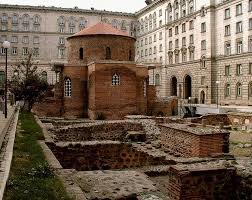Rotunda of St George the Victorious is the most ancient Roman construction in the city in a state of good preservation. It is part of the ancient complex of buildings erected at the beginning of the fourth century AD during the reign of Emperor Constantine I the Great (306-337). 
The rotunda is a cylindrical construction with a cupola, built on a square foundation. It is 9.75 metres in diameter at its base and the height of the cupola is 13.70 metres. The earliest medieval fresco layer dates back to the ninth to tenth century AD. The later frescoes are from the twelfth and the fifteenth century AD.
In the fifteenth century the church was a metropolitan church. At the beginning of the sixteenth century it was turned into a mosque and the frescoes were covered with a layer of plaster, fragments of which have been preserved on the western wall. In 1469 the holy remains of St. Ivan Rilski stayed here for a whole week on their way from Tarnovo to the Rila monastery. The holy remains of the Serbian king St. Stefan Urosh II Milutin (1282-1321), which were transported later to St. Sofia church, were also kept here.






